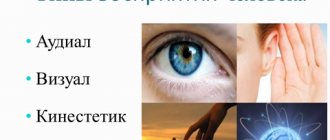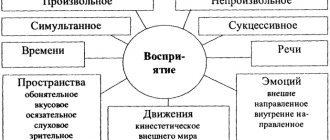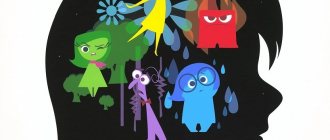Channels of perception
Channels of perception are a certain range of perceived information. Each person's channels of perception are developed in their own way.
In psychology and NLP, these channels are also called modalities. Although in NLP the concept of “modality” is somewhat broader than in psychology.
Note: NLP is neuro-linguistic programming.
In this article, information on the subject of consideration will be given in a general form, for informational purposes only. Simply, this information will be useful for understanding some of the processes occurring in the human body when performing yoga exercises (asanas).
We will talk about ways to obtain information. The methods of processing the received information belong to the representative system.
A person has five senses with which he perceives the surrounding material world: eyes, ears, nose, mouth, skin. (Some believe that there is a sixth sense organ - the vestibular apparatus, which is responsible for the sense of balance and body position in space).
Signals from the senses cause corresponding sensations. There are six external sensations in total. Five of them correspond to the senses: vision, hearing, smell, taste, touch (tactile sensations) and, additionally, kinesthetic sensations. (Motility causes sensations, although it does not have a separate sensory organ.)
Sense organs and motor skills are channels for perceiving information . As already mentioned, each person has these channels developed in their own way. They have different degrees of development. And since all processes in the body are interconnected, the way information is perceived affects a person’s behavioral and somatic reactions. (Note: soma is the body).
There is also a reverse influence of behavior and somatics on the channels of perception . This feature of the human body is used in yoga to develop the senses and the ability to perceive and display information.
Let's consider some channels of perception and the features of their manifestation at the level of somatics and behavioral reactions.
Auditory child
These children remember in great detail who said what, where, when, and in what words. They instantly “grab” first names and patronymics, but easily forget faces. Their greatest pleasure is conversation; they will never be interested in a book if they have someone to talk to. All secrets and news immediately become known to them. No, they are not specifically trying to find out what you are talking about, it’s just that their hearing is much better developed than others. Auditory children have a large vocabulary, but may lag slightly behind their peers in the development of skills related to visual (finding differences in pictures) and motor (the ability to deftly climb a slide, run quickly and for a long time) perception.
In their speech, auditory learners often use the words “listen”, “hear”, “noisy”, “quiet”.
Such children think through internal speech, mentally pronouncing their own remarks and the interlocutor’s answers, assuming what kind of voice he will have, what intonation. They love the radio. They like television programs that are dominated by “words” rather than “pictures.” They are very attentive in conversations. In a conversation with an auditory speaker, it is useful to use vocal features: pauses, intonation, volume.
In primary school, auditory learners often study well; their strength is developed auditory memory and speech, but they often have difficulties with spelling and drawing. In middle school, auditory learners who are accustomed to using their memory usually demonstrate significantly less success. During this period, you should pay more attention to reading, pronouncing, and repeating the rules out loud. Auditory learners are musical and easily grasp foreign languages. They are recommended to use audio materials first. When doing homework, such children may move their lips and talk to themselves. Another feature of auditory learners that is associated with difficulties at school is the ability to tell only from the very beginning.
Visual (visual) channel
If a person has a dominant visual channel (or is currently configured to perceive video information), then outwardly this will be expressed in the following signs:
1. The eyes will look up, above the horizon line. Which is quite understandable: the sky is above, the sun is there - there is more light there;
2. Upper, chest breathing;
3. Voice is high;
4. Speech is fast, sometimes excitedly. There is often a noticeable increase in intonation towards the end of a sentence. Which is also understandable: upper breathing is the most ineffective - a small volume of air is inhaled and during exhalation you need to have time to express a thought, finish a sentence;
5. All gestures from above - at the level of the shoulder girdle and above;
6. Such a person likes to dress brightly;
7. Appearance: pale face. The body is most often slender and thin. The shoulders are relatively broad and usually raised. The head is thrown back;
8. Predicates: light, dark, bright, beautiful, see, look,... That is, words that relate to the characteristics of light, color and visual perception.
Note: Predicates are words that a person uses to describe his or her perceptions.
The visual channel is associated with the ajna chakra (third eye), as well as with the mental body.
Visual child
Visual learners instantly remember faces, but often forget first and last names. They easily find their way even to places they have only been to once. The speech of visual children is filled with the words “look”, “have you seen”, “beautiful”, “bright”, “red”, “green”... They think in images. In the process of thinking, pictures from the past, ideas about the future, images appear in their heads, and imaginary situations are played out. Little visual learners have a wild and lively imagination.
Children with visual perception do not like hugs and kisses, but they will willingly talk to you about adult topics. They usually look older than their age because they keep themselves aloof and a little arrogant. They love to lecture their elders and quote phrases “from TV,” which they adore. They sense your mood and desires by your facial expressions, but do not always let you understand this (of course, in their own interests). Visual learners have excellent visual memory and fine motor skills are well developed, but they have difficulty understanding verbal instructions and often repeat tasks. Quickly remembers color, shape, size. They find it easy to tell stories based on pictures. Their eyes are always searching for information.
Visual children begin to write in block letters early and can read quite fluently by the time they reach school. In raising a visual student, it is necessary to pay attention to the development of speech (he is taciturn), sociability (the ability to communicate), and physical coordination. Visual students remember the teacher’s explanations more easily if they are duplicated on the school board or on diagram posters: it is easier for them to see and visually remember the word than to understand the rule why they should write it that way. Visual aids, illustrations, the use of colored pencils: sketch, reproduce, highlight - all this contributes to better assimilation of the material.
Allow your child to use colored pens to highlight important points in the book. As visual learners, it is vital for them to have a draft in which they can draw and draw.
Auditory (hearing) channel
If a person has a dominant auditory channel , then outwardly this will be expressed in the following signs:
1. The eyes will move approximately in a horizontal plane, along the horizon line. This is due to the fact that an auditory person is tuned to perceive sounds. In nature, sounds that deserve attention usually occur at ground level, or at a short distance from it;
2. Medium, costal breathing;
3. The voice is average - not high and not low;
4. Speech is expressive, smooth, without raising or lowering intonation;
5. Gesturing at an average level, approximately at chest level. This is table or podium level;
6. In clothes, such a person prefers an official style, or at least not too bright;
7. Appearance: the face is evenly colored, the body type may be different;
8. Predicates: quiet, loud, listen, noisy, heard, etc. - words related to the characteristics of sound;
The auditory channel is to some extent connected with the chakras: manipura, anahata and vishuddha. And also with the astral body.
Presentation of information
According to this parameter, information can be divided into the following types:
- Text. It is represented in the form of all kinds of symbols, which, when combined with each other, make it possible to obtain words, phrases, sentences in any language.
- Numeric. This is information represented by numbers and signs that express a certain mathematical operation.
- Sound. This is directly oral speech, thanks to which information from one person is transmitted to another, and various audio recordings.
- Graphic. It includes diagrams, graphs, drawings and other images.
Perception and presentation of information are inextricably linked. Each person tries to choose exactly the option for presenting data that will ensure the best understanding of it.
Kinesthetic channel
If a person has a dominant kinesthetic channel , then outwardly this will be expressed in the following signs:
1. Eyes will be cast down;
2. Breathing from the bottom, with the stomach (abdominal or diaphragmatic);
3. Voice is low;
4. Speech is slow, often with a decrease in intonation towards the end of the sentence;
5. Gesticulation below, usually below chest level;
6. Prefers comfortable clothes, appearance does not matter much;
7. The face is ruddy, the body type can be different, usually medium or heavy;
8. Predicates: light, comfortable, heavy, feel,... I.e. words that describe the sphere of sensations.
The kinesthetic channel is associated with the physical and etheric body and with the muladhara and svadhisthana chakras.
Helpful information
The three main channels of perception and external signs of their manifestation in humans are described above. These channels are used in the first stages of mastering yoga. This information is also useful for use in everyday life and in business communication.
Of course, mutual understanding is possible only between those people who communicate on the same channel of perception.
Of course, there are people who have developed all channels. Although, as a rule, one channel dominates or they prefer to communicate on one.
In order to establish contact with a person (establish rapport, as psychologists say), you need to tune into his channel of perception.
Additional Information
Of course, in addition to those listed above, there are other channels of perception.
— Digital (or logical) channel. Deserves special attention. Creates many problems for the owner. Such a person comprehends everything. And he may not perceive anything. He lives in ideas.
He knows that there is pain of loss, anxiety or love , but he just doesn’t feel it. He looks at beauty and cannot admire it. Listens to music and does not hear the harmony of sounds.
Such a person lives in the inner world. Once formed impressions.
This type of perception usually develops as a result of strong dramatic experiences. As a way to get away from these very experiences.
A person of this type of perception acts distantly, is most often secretive, shy, and constrained in his movements.
The digital channel is connected with the mental body.
— The gustatory and olfactory channels in NLP are classified as kinesthetic, although they have a completely independent meaning. Energetically connected to the ajna chakra (third eye). And in this sense it is closer to the video channel.
At the somatic level, they manifest themselves in complex ways.
Thus, on the olfactory channel, breathing will most likely be upper (video channel), and eye movements and gestures will correspond to the auditory and kinesthetic channels of perception.
Taste channel - breathing and gesturing will most likely be mid to upper, and the eyes will be looking down.
In addition, there are also : the intuitive channel, the channels of supersensible perception, and the dream channels.
The channels of perception listed in this chapter, except for the digital one, are considered and practiced already at the stages of Raja Yoga.
What is information?
The concept of “information” has an abstract meaning and its definition largely depends on the context. Translated from Latin, this word means “clarification”, “presentation”, “familiarization”. Most often, the term “information” refers to new facts that are perceived and understood by a person, and also found useful. In the process of processing this information received for the first time, people gain certain knowledge.
Digital representational system
Scientists identified this system of perception not so long ago. For a person with such a representative system, symbols - words and numbers - come first when perceiving the world around them. Their type of perception is aimed at logical justification of everything that happens around them. Digitals are excellent strategists. They are excellent at planning and handling details. Solving complex problems is their strong point. Information is processed and remembered step by step, sequentially, methodically, logically, putting everything on the shelves. They need a certain amount of time to process information. Therefore, new ideas, situations, people are not immediately perceived. They need time to think and comprehend.










